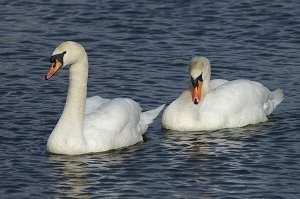Mute Swan🠉
Cygnus olor

Very large, with a very long neck. White. Tail long and pointed. The neck may be either held straight as in Whooper Swan or held in an S-curve. The threat posture is distinctive, with the wings held in a raised position and the head lowered. Bill orange-red with a knob at the base. This knob, the nostrils and the nail of the bill are black. In flight, difficult to distinguish from Whooper Swan apart from by the colour of the bill in adults. Juveniles are more contrasting above. Produces a characteristic hollow throbbing sound in flight.
Juvenile: grey-brown with a pinkish tinge. The dark grey bill becomes greyish-flesh and lacks the knob.
Voice: the call is a breathy “vheeor”. A “gooah” similar to the call of a gull is also heard.
L. 140-160 cm ; W. 200-240 cm.
Similar species : Whooper Swan, Bewick's Swan.
©Thomas Galewski
Bewick's Swan🠉
Cygnus columbianus

The smallest of the three swans, with a proportionally shorter neck, larger head and stockier body. The bill is stubbier than in Whooper Swan and not as straight. The most distinctive feature for separating the two species is the proportion of yellow and black on the bill. Le Bewick has a little less yellow than black, and the yellow forms a patch that is rectangular or rounded (rarely triangular) and does not extend further forward than the nostrils. The gape area also has more black.
Juvenile: greyish. As in juvenile Whooper Swan, the adult bill pattern can be made out in the juvenile.
Voice: calls are similar to those of the Whooper Swan but are higher-pitched on average and slightly more slurred. Usually given singly or in pairs.
L. 115-127 cm ; W. 170-195 cm.
Similar species : Whooper Swan, Mute Swan.
©Thomas Galewski
Whooper Swan🠉
Cygnus cygnus
Like the Mute Swan, very large with a long neck. White. Differs from Bewick’s Swan by a long, straight, wedge-shaped bill which is mainly yellow; the yellow extends beyond the nostrils in a point. The tip and upper and lower edges of the bill are black. A faint hissing is produced in flight.
Juvenile: brownish-grey, clearly greyer and paler than young Mute Swan. Very similar to juvenile Bewick’s Swan. The adult bill pattern can be discerned in the juvenile, with the black at first replaced with pinkish and the yellow with dirty white .
Voice: Very noisy; the calls are strident, similar to those of Bewick’s Swan but more resonant and lower-pitched on average: “kloo-kloo-kloo” in groups of three or four.
L. 140-160 cm ; W. 205-235 cm.
Similar species : Cygne tuberculé, Cygne de Bewick.
©Thomas Galewski




.png)
